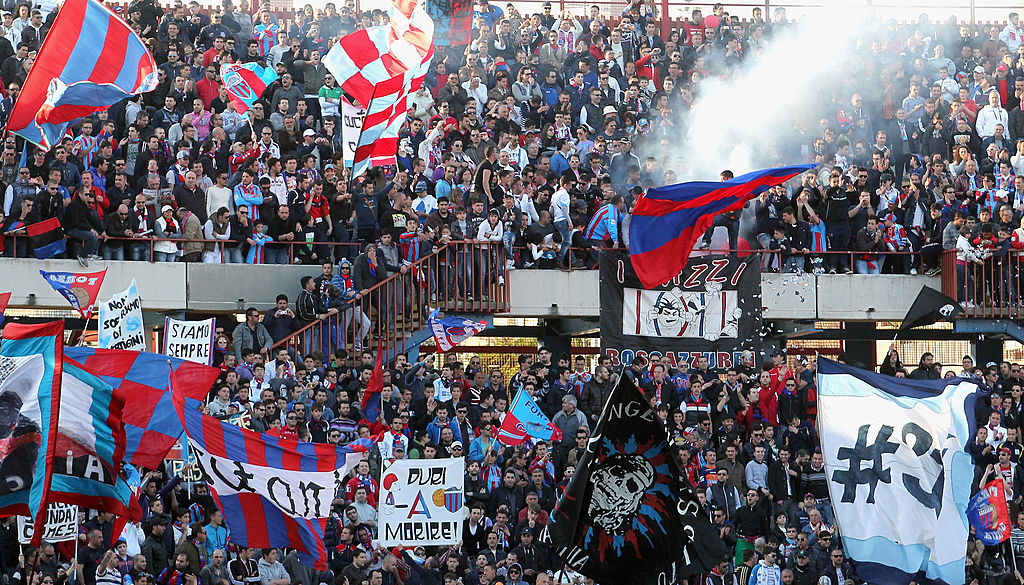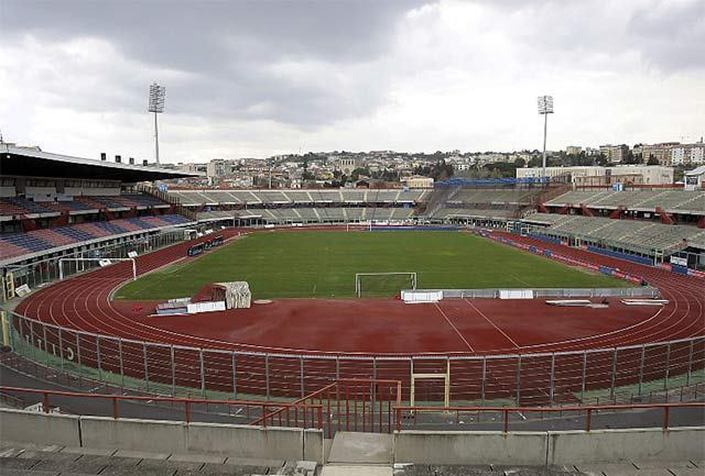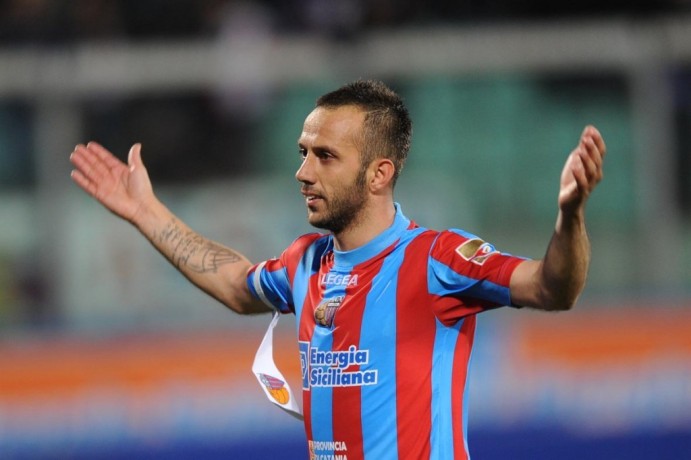Stadium: Stadio Angelo Massimino, capacity 23,420
Sicily can be as violent as it is beautiful and the Stadio Angelo Massimino is no different. The stadium has a fantastic setting, but its history is marred by recent events. Constructed in 1937, the ground has not been modified as much as other stadiums in the Peninsula, but its atmosphere is second to none. The extremely passionate Catania supporters are loudest in the Curva Nord, where many of their Ultra groups reside – and they provide a spectacle of colour, flags, flares and choreography.The dark side of the ground was never more evident than when Palermo visited the stadium for a derby match in 2007. Police officer Filippo Raciti was trying to break up a fight outside the stadium when he was struck by an object and died as a result of liver damage. The trouble had broken out as police had tried to stop Palermo fans entering the stadium midway through the match. The match was abandoned, and the Italian FA suspended all football for a week. Catania were banned from playing in their stadium for the next five months.
The Ultras
The air filling the baroque-styled streets surrounding Catania’s Stadio Angelo Massimino is thick with the fumes of tear gas and smoke. Palermo’s David di Michele has earned a famous victory in the Sicilian derby, much to the chagrin of the Catania Ultras. But while the battle on the field is lost, the war on the streets has just begun.
The Catania fans vent their fury at the police. Homemade bombs, flares, firecrackers, pipes, rocks, pieces of sink and even a scooter rain down on the authorities. The cacophony of explosions, helicopters and yells almost drown out the approaching ambulance sirens. Amid the maelstrom a policemen lies fatally injured.
Allegedly struck by a broken sink and a missile which exploded in his vicinity, he would later die from his injuries in hospital. The officer’s name was Filippo Raciti and the events of 2 February 2007 remain one of the most ignominious in the history of Italian football. Life on the Curve would never be the same again.
The day after Raciti’s death, Gazzetta Dello Sport ran the headline “Poliziotto Ucciso Il Calcio Chiude” (“Policeman Murdered, Football Closes”). In his Guardian column James Richardson reported an “authentic ambush” on the police planned and co-ordinated by Catania Ultras. Italian football was reeling.
The Calciopoli match-fixing scandal in 2006 had revealed a dark underbelly, but this was something altogether more sinister. Calcio had been plunged into the global spotlight and sanctions were swift. Games were immediately postponed, and although Serie A returned the following week, radical changes were afoot.
Italy’s football chief Luca Pancalli said: “What we’re witnessing has nothing to do with soccer… Without drastic measures, we cannot play again.” The Football Stadia Act, also known as the Pisanu decree, involved a severe clamp down. Teams whose grounds weren’t up to standard (the majority across the Italian leagues) were forced to play behind closed doors. A ban was placed on pyrotechnics and the sale of block tickets to away supporters. Financial relationships between clubs and fan associations were prohibited.
Catania were forced to play the remainder of their games at a neutral venue and behind closed doors. The Stadio Massimino underwent major work to meet the newly introduced safety measures and did not re-open to fans until 2 September 2007, when Catania hosted Genoa. A minute of silence was observed for Filippo Raciti.
The events in 2007 encapsulate the disturbing side of Ultra culture. A continuation of strict measures such as the Tessera del Tifoso (supporters ID card) has at times threatened their very existence. However, while Catania’s Ultras will always be synonymous with the tragic death of officer Raciti, their loyalty and passion was fundamental in leading Catania to the summit of Italian football.
Over the years the Massimino has seen a number of Ultra groups take eminence on both Curve. Two of Catania’s more renowned groups are Falange d’Assalto Rossazzurra (Red and Blue Assault Phalanx) and Primo Amore (First Love), later renamed Irriducibili (Unbreakables).
Falange (1979) were Catania’s first Ultra group and resided in the Curva Nord. Their incursion saw the birth of other groups such as Onda d’Urto (Shockwave) and Giovani Rossoazzurri (Young Red and Blues), the latter’s members moved to the Curva Sud and in 1991 founded the Irriducibili.
In Catania’s case it seems the habitual internal divisions were exemplified in the varying degrees of prominence enjoyed by both Curve. While the Curva Sud was the heartbeat of the stadium during the late 1990s, the Nord remains one of the most atmospheric in Italy today and its effervescence is said to be the reason Catania remain one of the biggest clubs in Sicily.
In 1993, Catania were perennial strugglers and their financial problems had seen them relegated to Eccellenza (the sixth tier of Italian football). Franco Proto, president of Atletico Leonzio, a team from Lentini (just 20 miles from Catania) sought to take advantage of this situation by moving Leonzio and forming Atletico Catania.
However, the Catania fans rejected this team, preferring to stay faithful to their beloved Rossoazzura. New recruits grew through the lower leagues and they formed the group A sostegno di una fede (In support of a faith). Despite languishing in the depths of despair, Catania’s following was ever-present and theCurva Nord was alive with an array of flags, banners and colourful smoke effects.
When it comes to rivalries, Catania against Palermo is as fierce as they come. Messina, another prominent Sicilian club, come a close second. Other noteworthy enemies include Catanazaro, Taranto (especially for their blasphemous chants insulting Catania’s patron saint, Agatha), Reggina, Salernitana, Avellino and Siracusa. Catania’s Ultras have good relations with Crotone and Trapani, the latter being based on common hatred of Palermo.
The city of Catania lies in the shadow of the imposing Mount Etna – in local tongue “A Muntagna“. Remarkably, lava was one of the materials used to rebuild the city following the volcano’s eruption in the 17th century. The volcanic stoned pavements are a constant reminder of the city’s tragic but explosive past, and while the picturesque Stadio Massimino has often produced beautiful matchday choreographies, their Ultras are as volatile and eruptive as their volcanic neighbour.
CLASSIC PLAYER: GIUSEPPE MASCAR
“I must say that it is already an honour to play for Catania. They are my hometown club and I always try to give my best on the pitch every week.”
Catania frontman Giuseppe Mascara gave this sumple statement to the press in 2009. It was humble, honest and hugely understated, as the Sicilian forward was much more than just a local boy done good.
At just under six feet tall and with a very slight frame, Mascara did not look like a natural athlete and was perhaps not in keeping with the Spartan forwards we see today. Even so, his hard work and quick thinking gave him an unnatural ability to score spectacular goals.
Mascara joined Catania in 2003, a move that thrilled the young striker who returned home to Sicily. This was the zenith of his career and he took to the task of establishing Catania as a top-flight club with vigour. Soon his team had made it to Serie A and his continued efforts saw him adapt to the division. He slowly began to make a name for himself.
His best season for Catania (and possibly his enter career) was in 2008-09. Playing under Walter Zenga, he scored 12 times in 34 games, including one of the goals of the season against hated rivals Palermo when his 55-yard lob beat Marco Amelia in the opposition goal.
Mascara was also known for the amount of research he would do before games, working on goalkeeper’s habits and defenders’ frailties. Zenga remembers him asking frequently for reports on the opposition’s custodian.
Mascara left Catania in 2011 for Napoli but never regained the form he found at his boyhood club. When Calcio ruled the world, Mascara was helping Catania arrive in style.



